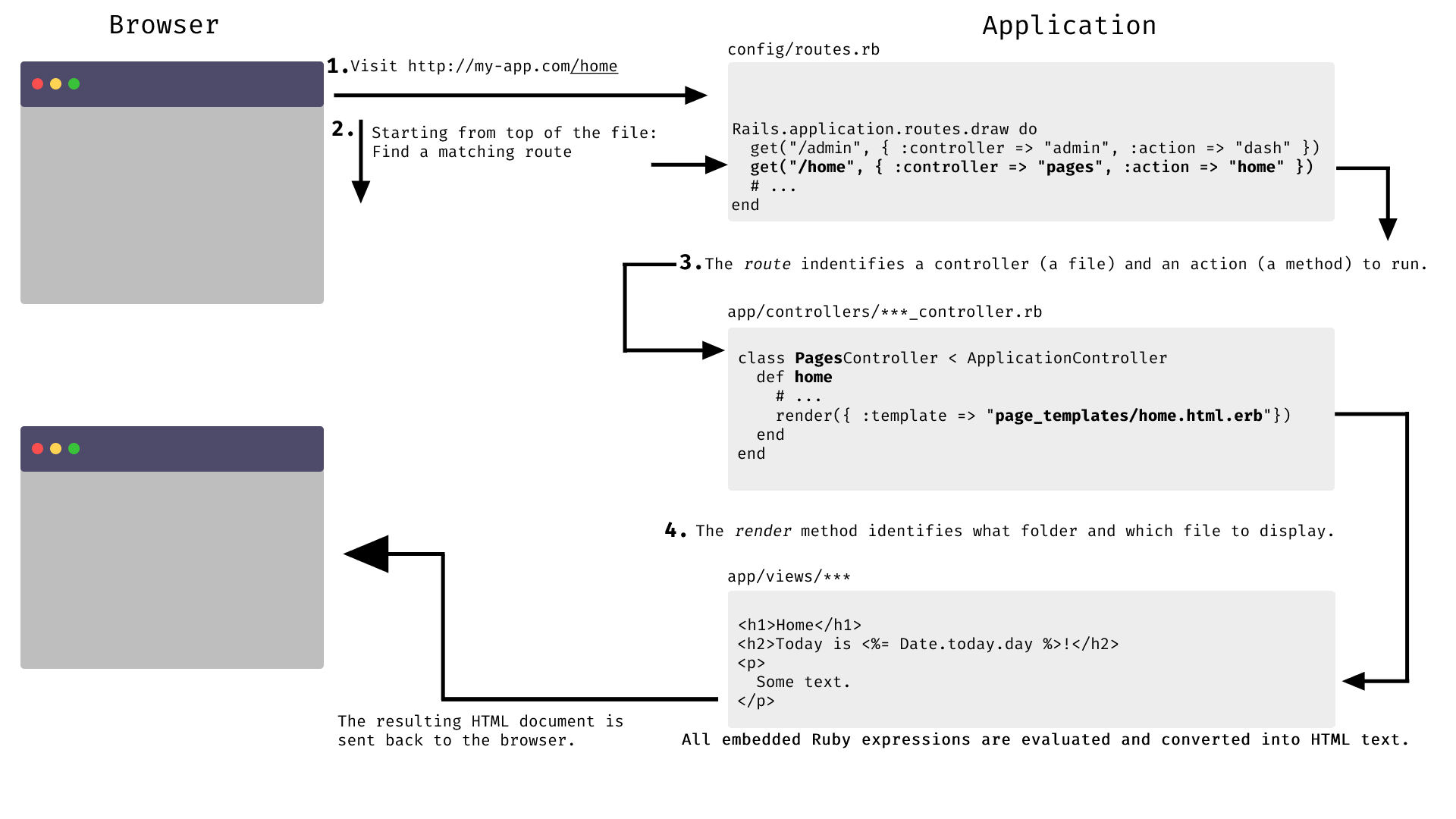2.15 Addendum: RCAV Flowchart
Our apps are nothing more than a collection of URLs that we decide to allow users to access:
- mydomain.com/products
- mydomain.com/photos/193
- mydomain.com/signin
So remember: everything always starts with a route between an address we want users to be able to visit and a Ruby method that will be responsible for generating a response to the user’s browser.
In order to support a URL in your app such as https://3000-your-gitpod-workspace.gitpod.io/home, there are a lot of dots to connect!

A user visits an address in our app; in this case, we chose /home.
If we want to allow users to visit that address, we have to add a route for it in
config/routes.rb.The complete route looks like this:
get("/home", { :controller => "pages", :action => "home" })Here’s what’s going on:
A route is defined using the
get()method, which has two arguments. The first argument is aStringthat contains the address we want to support; in this case,"/home".The second argument to
get()is aHashthat tells Rails what to do when someone visits the address. TheHashhas two keys::controllerand:action.“Controllers” contain the logic of how to respond to requests (they’re just Ruby classes).
“Actions” are the actual logic that gets executed by Rails when a user visits an address (they’re just Ruby methods).
The key
:controllermust go to the name of a Ruby class; in this case, we chose"pages".The key
:actionmust go to the name of a Ruby method that we want Rails to execute when a user visits /home; in this case, we chose"home". This name is not required to match the route.Rails finds a match for the controller name we specified in the
app/controllers/folder. Files that contain controllers must always end in_controller.rb, and begin with what we said in the route would be the name of the controller; in this case,pages_controller.rb.Rails finds the Ruby class in the file. The name of the class must be
CamelCasedand always end in...Controller < ApplicationController. In this case,PagesController < ApplicationController.Rails finds the method we specified as the action and executes it; in this case, we defined a method called
home.We can write as much or as little Ruby as necessary within the action to satisfy the request — reading from APIs, doing math, whatever.
Once we’ve computed the final values that should be displayed to the user, we tell Rails the name of an HTML view template to use to format the output. To do so, we use the
render()method. The completerender()method looks like this:render({ :template => "page_templates/home.html.erb"})Here’s what’s going on:
render()takes one argument, aHash. The Hash must have a key,:template, with aStringvalue. TheStringspecifies the location of an Embedded Ruby HTML template to use to format the output. The first part of theStringspecifies the name of a folder, in this casepages_templatesand the second part of theStringspecifies the name of a file, in this casehome.html.erb.We have to create a folder within
app/views/that matches the name that we specified in therender()statement.We have to create a file within that folder that matches the name that we specified in the
render()statement.Finally, if we’ve connected all the dots correctly, Rails will embed the variables in the
.html.erbtemplate, produce a final plain.htmlfile, and send it back to the user’s browser. Hurray!
If you didn’t connect the dots correctly, you will usually see a very descriptive error message; try to read and understand it.
Some things to keep in mind:
- Capitalization (all file, folder, method, variable, and symbol names should be
snake_case; only class names areCamelCase). - Spelling/pluralization matters (by convention, controller names are usually plural, but don’t have to be).
- Location (controller files must be in
app/controllers/). - READ THE ERROR MESSAGE! It usually tells you exactly what is going wrong, and where. It will at least give you a strong hint.